This approach involves trimming the tissue to an extremely narrow and peaked pyramid, see diagram:

From this technique, a greater number of serial sections can be picked up in sequence, on a single slotted grid. One disadvantage is that the earliest sections may have to be ignored because they are the narrowest. There remain, however, a great number of sections that are more than adequate in size for photography. See diagram:
Materials: The same materials used in serial sectioning plus the square cornered 90-degree Cryo-Trim tool (custom-made for Dr. Harris by Electron Microscopy Sciences, Fort Washington, PA).
Procedure:
A. To trim the Ridge.
It is first assumed that the block has been previously sectioned while positioned at 0, 0 degree settings in the ultramicrotome. This pre-requisite is necessary for good “ribboning” of the serial sections. See chapter on serial sectioning.
- The most practical strategy is to trim the left and right sides first. One can use the square-cornered trim tool, since the left and right sides are not as critical. Alternatively, one can use the 45-degree sloped trim tool to create all four sides of the peaked pyramid. It is the top and bottom sides (or north/south facets) which are critical to the precise linking of one section to the next. Therefore, the top and bottom sides must be trimmed neatly and parallel to each other! To begin, set the knife clearance angle to about 3 to 6 degrees. Electron Microscopy Sciences recommends that newer trim tools should be used at the smallest clearance angle as possible, i.e., from 0 to 3 degrees. As the knife ages with use, then increase the angle. Such small angles, however, make it impossible to see a cast reflection on the block face, especially on the older models of ultramicrotomes, e.g., the Ultracut E. For this reason, we set the angle to 3 degrees and greater, even when using new trim tool knives. Next, decide whether the left or right side will be trimmed first. Decide also whether this first side will be angled or straight. In this instance, we choose to start with the left side (west side) and to angle it. WHEN WORKING WITH THE ULTRAMICROTOME, REMEMBER TO SECURELY TIGHTEN DOWN ALL COMPONENTS!
- Align the right straight edge of the trim tool/knife to the area of interest on the block face. It may be necessary to turn off overhead lighting and use only the ultramicrotome’s backlight source, to really obtain a good alignment. When finished with alignment, then retract the knife from the block a few mm, a safe distance. See diagram:
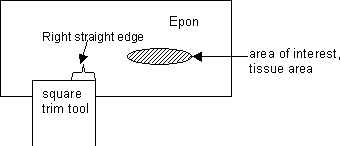
- Set the cutting speed to 1mm/sec.
- Set the section thickness to 0.5 or 1um increments.
- Rotate the block/chuck 10 degrees counter-clockwise (CCW). This is equivalent to two divisions, on either of the Leica Ultramicrotomes, E or T.
- Set the length of the cutting window.
- Re-align the right straight edge of the knife more precisely to the area of interest. Then, position the right corner of the knife to the exact area for trimming the intended left side. See diagram:
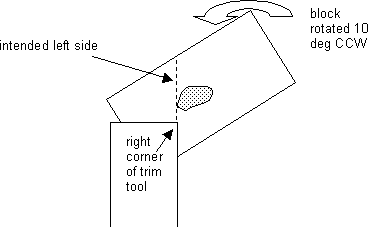
- Turn on the motor to the ultramicrotome and remove a total of 15um of Epon/tissue.
- When finished, stop the ultramicrotome, and retract the knife a safe distance away from the block face. Use Dust-Off to blow away the trimmings from the knife corner.
- Rotate the chuck 10 degree clockwise (CW).
- Move the knife stage over to the right. DO NOT CHANGE THE ANGLE OF THE TRIM TOOL! Position the left corner of the trim tool at a distance of 150 to 250 um away from the first cut or trim area. See diagram:
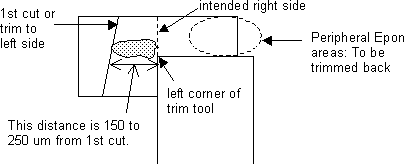
- Re-set the length of cutting window if it has changed significantly.
- Advance knife to the block face and turn on the ultramicrotome. Remove a total of 15um of Epon/tissue. Then stop the ultramicrotome. Retract the knife a safe distance. Use Dust-Off as needed. Remember to trim away the extreme ends of the Epon block, as described in the serial sectioning protocol.
- Rotate the chuck 90 degrees CW.
- Remove the square trim tool, if being used, and replace with the 45-degree sloped trim tool. Otherwise, continue using the 45-degree trim tool.
- Prepare to trim the proposed bottom of the pyramid first. Align the right straight edge of the trim near the area of interest. Then, retract the knife a safe distance.
- Set the length of the cutting window.
- Position the right corner of knife to the exact area where the bottom side is to be trimmed. See diagram:
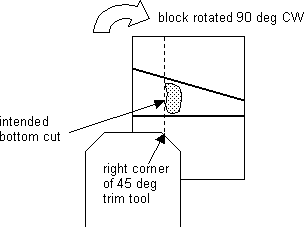
- Turn on the ultramicrotome and remove a total of 12um of Epon/tissue.
- When finished, stop the ultramicrotome and retract the knife.
- Move the knife stage over to the right. Position the left corner of the trim tool 24 um to the right of the newly cut bottom edge. See diagram:
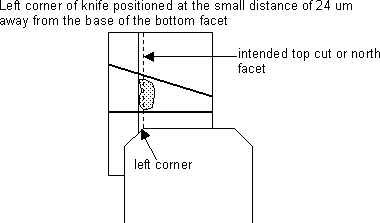
- Advance the knife close to block face and turn on ultramicrotome. Remove a total of 12 um of Epon/tissue.
- When finished, stop the ultramicrotome and retract the knife.
- Rotate chuck 90 degrees CCW.
- The final appearance is a narrow, elevated ridge of tissue, that is 12 um high and 24 um wide at its base. The length of the ridge can be from 150 to 250 um long. See diagram:

B. Serial sectioning the ridge pyramid.
- First, clean the trim tool with the alcohol-soaked Styrofoam rod, according to previous instructions. Store the trim tool away. Next, set the knife clearance angle to 6 degrees. Lock this setting in place. Then insert the thin sectioning diamond into the knife holder. Secure the knife in the holder. REMEMBER, ALL COMPONENTS TO ULTRAMICROTOME MUST BE SECURED TIGHTLY FOR SAFE AND PROPER CUTTING!
- Set the section thickness to the nanometer setting, for desired thin section thickness. For example, set to 50nm to obtain medium silver interference color, or set to 40 nm for light silver to gray sections.
- Set the length of the cutting window.
- The next step is to align the knife-edge to the region just below the ridge, since it is difficult and risky to align the knife to the ridge itself.
- Then retract the knife about 20 to 30um.
- For now, set the cutting speed to a relatively fast speed, e.g., 3mm/sec. The knife will be advancing toward the block, without cutting anything for the first approximate 8 to 18 um. Then, we will slow the cutting to 1mm/sec.
- Turn on the ultramicrotome. Observe the knife advancement in total microns on the LED. When about 8 to 18 um are displayed, depending on how far away the knife was to begin with, then slow the cutting speed down to 1mm/sec. Then wait and watch for the first sections to be cut with the diamond knife. The earliest sections will be extremely narrow. Subsequent sections will be larger and larger. Allow about 200 sections to be cut in the ribbon.
- When reaching 200 or so sections, then stop the ultramicrotome. Prepare to pick up the ribbon on a coated slot grid.
C. To pick a ribbon of sections.
- If the last section of a ribbon is still hanging on the knife-edge, gently tap it several times with an eyelash hair. This should dislodge it.
- Gently coax the ribbon away from the knife-edge to an area in the center of the boat, using the same eyelash hair stick. Alternatively, one can use the slotted grid to gently waft the ribbon to an appropriate area in the boat.
- Hold the slotted grid in the forceps at an angle. See diagram:
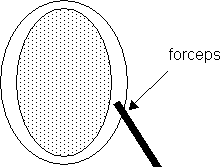
- Use the grid to waft the ribbon over towards the grid. Then submerse the grid so that only ¼ of the coated or filmed area within the slot is above the water level. Tilt the bottom edge of the grid a bit toward the ribbon. See diagram:
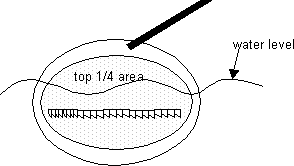
- Slowly, move the grid away from the ribbon. This action will pull the ribbon toward the grid. Then, move the grid toward the ribbon until it looks like they will touch. Try this back and forth wafting a few times to “lure” the ribbon closer and closer to the grid. Again, when it seems the ribbon is about to contact the grid, then pull the grid straight out of the water. Hopefully, the ribbon is now on the grid. See diagram:
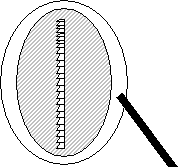
- Place this grid aside to dry for several minutes.
- Before storing the dry grid into the grid box, check to see if any residual water remains between the prongs of the forceps. Wick dry with a filter paper or Ross Lens tissue in that case. Then store grid away.
- That’s it!